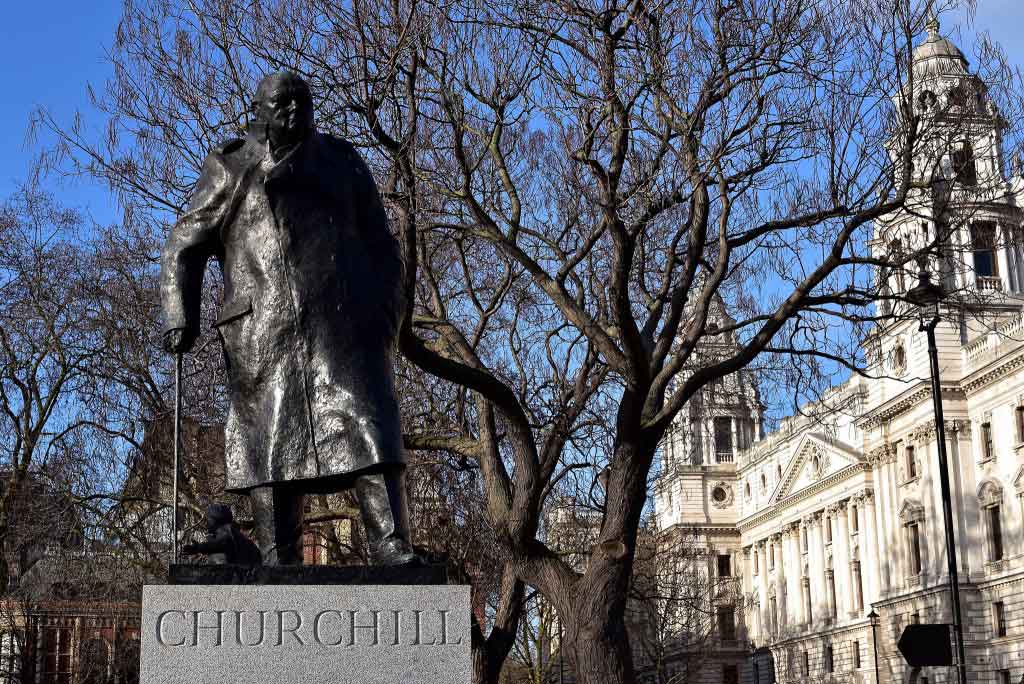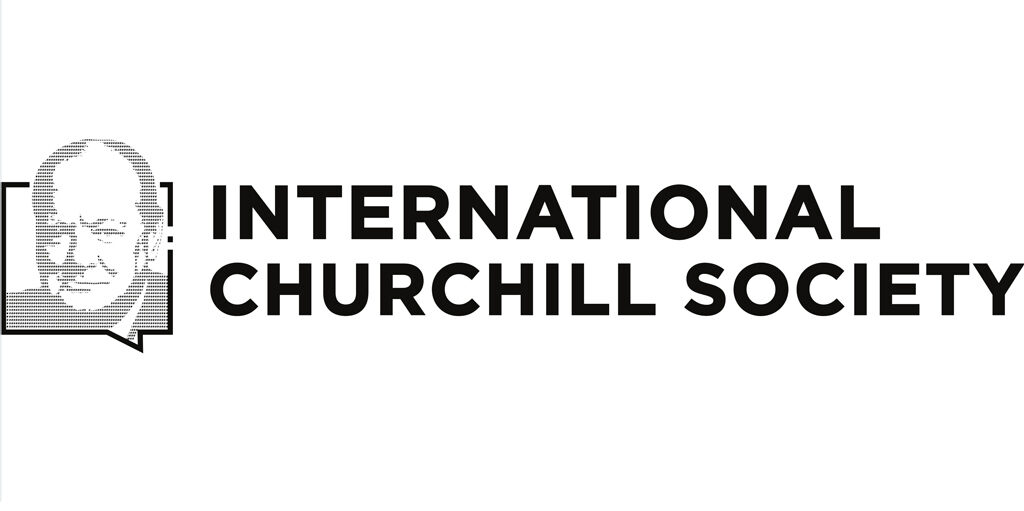
Finest Hour 141
Churchill Proceedings – From Disaster to Deliverance: Churchill and the War in Southeast Asia, 1941-1945

Winston Churchill, Parliament Square, London © Sue Lowry & Magellan PR
June 9, 2013
Finest Hour 141, Winter 2008-09
Page 43
Churchill Proceedings – From Disaster to Deliverance: Churchill and the War in Southeast Asia, 1941-1945
By James Boutilier

2025 International Churchill Conference
Dr. Boutilier is Special Adviser (Policy), Canadian Maritime Forces Pacific Headquarters. He addressed our Vancouver Conference on 14 September 2007. This article has been reduced considerably from the original in view of previously published Pacific War papers (FH 138-40). The original is available by email from the editor. The views presented in this paper are those of the author only and do not represent the official policy of the Department of National Defence.
Paradoxically, while the Second World War in Southeast Asia had profound political ramifications, Churchill thought it a sideshow, faced as he was with a strategic dilemma of how to be strong in far-flung regions. What British wartime planning there was was based on wishful thinking, self-delusion and flawed perceptions. Ironically, Japanese militarists succumbed to the same fatal mixture, relying on improvisation and false hopes once their Asian blitzkrieg had run its course. For London and Tokyo, the fate of British possessions in Southeast Asia—Singapore, Malaya, and Burma—was of secondary importance to safe-guarding India (for Britain) or conquering China (for Japan). British Southeast Asia, and more precisely Burma, was the key to those ambitions. The British fought to save their empire, only to lose it. The Japanese fought to gain an empire, only to fail disastrously.
The bitter and deadly struggle in the rain-sodden jungles of Southeast Asia revealed the inherent hollowness of imperial pretensions. Despite a brief respite in the mid-1940s, the British lost India, the great barrack of Asia. Japan’s effort in China was an unalloyed failure and the Sino-Japanese conflict set in train forces that would result in the emergence of a new great power, the People’s Republic of China.
Churchill, as First Lord of the Admiralty and then as Prime Minister, assigned primacy to the Mediterranean. Underpinning this strategy were two flawed premises. First, in March 1939, Churchill drafted a memo which embodied the conventional wisdom of the day, namely, that the submarine threat had been mastered and that airpower would “not prevent [the] full exercise of … superior seapower,”1 in short, surface vessels. Second, Churchill thought that even if Italy entered the war, the Royal Navy could clear the Mediterranean and be poised to redeploy in defence of Southeast Asia, Singapore in particular. This was a grand and optimistic vision of British seapower at work. The reality would prove different.
Compounding this best-case scenario was the hope, excruciatingly thin at times, that in the event of Japanese hostilities, the United States would come to Britain’s aid. But Churchill doubted that the Japanese would ever undertake such a long-range venture as an attack on Singapore. Even if they did, Singapore’s great guns could surely hold the Imperial Japanese Navy at bay until the Royal Navy dispatched reinforcements. The British were also scathingly dismissive of the fighting capabilities of Japanese pilots and infantrymen. The former, they said, had eyes ill-suited to night fighting; the latter were unable to make their way through tropical jungles.
Whatever the case, British strategy was to give the Japanese no occasion for offence in the hope that Tokyo would not embark on a military campaign outside China, where they had been bogged down for years, fighting both Chiang Kai-shek and the ragged battalions of Mao Tse-tung. If the Japanese could be appeased, even by the sacrificial forfeiture of Hong Kong, Britain could get on with defeating the Italians and focus on the real threat, Nazi Germany.
“Fortress Singapore” was the metaphor for Britain’s fatal proclivity for strategic delusion in the interwar years. Commenced in the 1920s, its great naval guns were thought to have rendered Britain’s strategic outpost impregnable. But as Singaporean strategists will tell you, the island’s first line of defence, then as now, is halfway up the Malay Peninsula. Here the Navy was not available; British air-power was inadequate; and the Army, to which ultimate responsibility was destined to shift, was woefully unprepared. As to the comforting reassurance that the Japanese could never advance swiftly through Malay jungles, someone had forgotten that Malaya boasted some of the best roads in the Empire. Worse, indeed much worse, the great rifles at Sembawang had armour-piercing shells designed to subdue enemy warships, not high-explosive munitions designed to shatter Japanese army formations. Thus, the stage was set for disaster.
On 11 November 1941, the Japanese enjoyed a serendipitous windfall. The German raider Atlantis boarded the steamer Automedon in the Indian Ocean and discovered a British Chiefs of Staff appreciation stating that “in the event of war with Japan, it would be impossible to hold Hong Kong, Malaya, or Singapore.”2 This was relayed to the Japanese naval attaché in Berlin, and plans were laid accordingly.
Some observers were prescient enough to appreciate Singapore’s vulnerability. The same day that Admiral Nagumo received the order to attack the American fleet at Pearl Harbor, HMS Prince of Wales, HMS Repulse and four destroyers arrived in Singapore. Curiously, this squadron, commanded by Vice-Admiral Sir Tom Philips, was designated Force Z, while Nagumo’s First Air Fleet had been designated Operation Z.3 Prince of Wales and Repulse were the alpha and omega of British seapower; the former was the Royal Navy’s most modern battleship, the latter one of its oldest battlecruisers.
On hand to see the warships arrive was Lady Diana Cooper, a society beauty who had just landed (with 100 suitcases) in Singapore with her husband, Alfred Duff Cooper, whom Churchill had dispatched to report on Southeast Asia. “Today,” she wrote, “a little fleet arrived to help….a lovely sight but on the petty side.”4
Duff Cooper wrote a scathing report about Singapore. To begin with, the command structure was hopelessly confused. The Commander-in-Chief Far East was Air Chief Marshal Sir Robert Brooke-Popham, whom the Coopers uncharitably labelled “old Pop-off.”5 He had no authority over the Navy or the civil administration in Malaya. The governor of Singapore and the High Commissioner for the Federated Malay States was Sir Thomas Shenton, dismissed derisively, on the basis of his colonial service in Africa, as “Tom Tom” Shenton. Malaya’s civilian defence secretary, C.A. Vlieland, asserted throughout 1940 that “the army was deluded by ‘the invention of the imaginary fortress of Singapore.’”6
Another commentator was General Archibald Wavell, Commander-in-Chief India. Wavell had been the celebrated hero of British resistance in North Africa, but his professional career had come dangerously unstuck in the aftermath of the debacle in Crete and Churchill had shipped him off to New Delhi. In India, Wavell embarked on a “liaison” or fact-finding mission to Southeast Asia. He was “horrified” by what he discovered in Burma, where there was a “complete lack of organization, of military intelligence, and of planning generally to meet any Japanese attack.”7 Wavell knew from his time in the War Office in the 1920s about Singapore’s reputation as the Gibraltar of the Far East, but Major-General Arthur Percival, the General Officer Commanding, Malaya Command, warned that the Japanese might very well “burgle Malaya by the back door,”8 thereby laying Singapore open to attack. But Wavell misread the situation, reporting on 8 November 1941 that “I should think the Jap has a very poor chance of successfully attacking Malaya and I don’t think, myself, that there is much prospect of his trying.”9
A month later, the Japanese crossed into northern Malaya and Admiral Philips led his ships up the east coast of the Malay Peninsula in an effort to interdict Japanese troop transports. Bereft of airpower, Prince of Wales and Repulse were quickly sunk by Japanese aircraft (see Singapore papers, FH 139: 40-49). “The relentless demonstration of Japanese technological prowess,” Christopher Bayly and Tim Harper observed, “did more to break civilian and military resistance than any other factor.”10
There was an iconic quality about the event. It captured, tragically, the inadequacy of the British response and the dangers inherent in underestimating your opponent. The good news for Churchill was that come what may, he had avoided one of the conditions that he feared almost more than anything else: he was not obliged to lead his nation against the Japanese without American support. The bad news was that the strategic landscape had suddenly become far more complex. American entry into the war in the Pacific meant that the fate of British Southeast Asia and India had become inextricably linked with American efforts to aid Chiang Kaishek in China against the Japanese. In the dark days of December, Churchill was confronted with managing the increasingly asymmetrical politics of allied warfare.
The Japanese carried everything before them as they marched or bicycled down the peninsula towards Singapore. British troops lacked resolution and found themselves being swept along with thousands of panic-stricken residents “carrying personal effects such as carpets, rattan chairs, golf clubs, tennis rackets, and even canaries in cages.”11 When the British blew up part of the causeway leading to Singapore to inhibit the Japanese advance, the explosion was heard at Raffles College some miles away. When the headmaster enquired what the sound was, one of the students piped up, “[t]hat is the end of the British Empire.”12 The young Chinese lad was none other than Lee Kwan Yew, first prime minister of the Republic of Singapore in 1959-60. Five days later the garrison of over 85,000 surrendered to an assault force of roughly 30,000 Japanese.13 President Roosevelt had referred to 7 December 1941 as the “day of infamy.” The Japanese applied the same description to 15 February 1942, because they saw it infamous that an army still able to fight should surrender.
What was astonishing was that the myth of British superiority and invincibility had survived for as long as it did; that a handful of planters, traders, district officers, and missionaries had managed to exercise power over millions who had succumbed to the notion that they were inherently inferior and needed to be led. It was surely one of the greatest triumphs of psychology that the world had ever seen.
What was Churchill’s responsibility? Many of the decisions regarding the fortification of Singapore were made while he was out of office in the 1930s, but as Chancellor of the Exchequer in the mid-1920s, he had hacked away at appropriations for the Senior Service and the Singapore base, writing in 1924 that there was not “the slightest chance of [war with Japan] in our lifetime.”14
When Churchill became First Lord of the Admiralty in 1939, it was arguably incumbent upon him to inform himself about Singapore’s defences. But he still imagined that, in extremis, capital ships could be deployed to deter or defeat the enemy. In his memoirs he conceded that “[m]y advisers ought to have known and I ought to have been told, and I ought to have asked.” But “the possibility of Singapore having no land-ward defences no more entered into my mind than that of a battleship being launched without a bottom.”15
In Churchill’s defence, the perilous strategic landscape— France fallen, German submarine offensives in the Atlantic, the dismal outlook in North Africa—was such that no individual could have successfully coped with such an array of assaults. But there are limits to this line of defence. And the Japanese did play into his hands in the sense that they, and the Germans, committed the ultimate blunder of declaring war on the United States. When asked on 23 December 1941, while visiting the White House, whether Singapore was “the key to the whole situation” in the Far East, Churchill replied, “[t]he key to the whole situation is the resolute manner in which the British and American democracies are going to throw themselves into the conflict.”16
It was just like him, in the midst of disaster, to be contemplating the road to deliverance; but deliverance came at a price. Churchill’s conduct of the war in Southeast Asia had now become increasingly subject to Washington’s priorities and to the vagaries of America’s war efforts in the Pacific. The arrival of the Japanese constituted an acute, perplexing, and even mortal dilemma for the subject peoples of Southeast Asia, whether hill tribesmen in Burma, Indian rubber planters in Malaya, or Chinese shopkeepers in Singapore. Were the Japanese really liberators? Did they dare cast their lot in with their fellow Asians?
The local Chinese and Indians sensed opportunity. The former were obliged to pay a vast sum of protection money to the invaders, but they drew inspiration from Chiang Kaishek’s resistance in far-off Chungking and from local members of the Malayan Communist Party. The Indians, soon to be inspired by the charismatic, even Churchillian leader, Subhas Chandra Bose, saw an alliance with Japan as a way of positioning themselves to overthrow British rule in India.
But the Japanese ran out of ideas after their lightning conquest of Southeast Asia between December 1941 and May 1942. They had gained access to the much-needed raw materials, but having thrown up a huge defensive perimeter, they were uncertain how to continue prosecuting the war. Their achievement was almost negative in character, because they saw themselves bargaining away some of their gains in order to achieve a negotiated peace with their opponents. However, no such offer was forthcoming. They began to move into Burma, but India remained an ill-defined objective.
The Second World War was more truly a “world” war than any other war in history. Developments in far-off places had a direct bearing on the fate of the British Empire in Southeast Asia. In June 1942, the Americans, materially assisted by their mastery of the Japanese Purple Code, inflicted a crushing defeat on the Imperial Japanese Navy, sinking three of its front-line carriers off the mid-Pacific islet of Midway. Later in the year, amid the paralyzing conditions of a Russian winter, Soviet forces beat the German 6th Army to its knees in the rubble of Stalingrad. These were the great turning points of the war. From then on the possibility of German and Japanese forces meeting somewhere in South Asia became a pipe dream, and Japan’s best hope was to hold what they had.
The war in Southeast Asia had, of course, to be seen within the larger context of the global effort, of scarce resources, and competing demands from other theatres. In Europe, Churchill continued to promote the primacy of campaigning in the Mediterranean but bit by bit he was obliged to recognize Britain’s diminished stature and the fact that the Americans, by virtue of their plethora of personnel and weapons, were determining who should enjoy senior commands. British admirals and generals tended to be assigned secondary and supporting roles, or were appointed to less important theatres.
Another embarrassing failure of arms occurred in Burma in 1943. Churchill reflected the prevailing pessimism about attacking Burma when he observed colourfully that it was like “eating the porcupine quill by quill.”17 Instead, he favoured some sort of seaborne assault against Japanese positions in Southeast Asia but conflicting demands for ships and landing craft meant that nothing came of his scheme.
A major appointment in 1943 was that of Lord Louis Mountbatten, a young admiral with impeccable royal connections, as Supreme Allied Commander South East Asia (SEAC). Mountbatten, whom American General Stilwell dismissed as a “matinee idol,” was the product of a bargain struck between the British and Americans, whereby the former got a marginal theatre in return for the latter securing the ultimate appointment, Supreme Allied Commander Europe. While the Americans, motivated by anti-imperial sentiments, referred to SEAC as “Save England’s Asian Colonies,” they had to concede that Mountbatten was energetic and charismatic. These were the very traits needed to combat the demoralization and defeatism prevalent in the India of the day.
Happily for the Allies, the Japanese had begun to succumb to those conditions themselves. So also had Emperor Hirohito, who, on hearing that the Americans were about to oust Japanese forces from the Solomon Islands, exploded angrily, “isn’t there some place where we can strike the United States? When and where are you people [his commanders] ever going to put up a good fight? And when are you ever going to fight a decisive battle?”18
Japan’s last rolls of the dice were the battles of Imphal and Kohima in Northeast India between March and July 1944. The British, to Japanese dismay, did not fall back as they had always done before, and the Japanese were beaten back into Burma. The Japanese remained as quick, flexible and innovative as always, but they were now facing a much more confident and well-equipped opponent. While the war was due to last another year, the rest was an extended afterward. The struggle increasingly became a political one for both the Japanese and the British in their former colonies.
The war in Southeast Asia unfolded on a huge canvas. The old order was swept away, collapsing ignominiously before the invaders. The peoples of Singapore, Malaya, and Burma were left confused and uncertain as they saw British, Australian and Indian forces melt away, defeated by a relentless foe. Those soldiers, sailors, and airmen were the hapless victims of imperial arrogance, faulty planning, and fatal self-delusion. As Wavell observed, the Japanese prevailed by “combining the fanaticism and mobility of the savage with modern weapons and training.”19
Field Marshal Slim called the flight out of Burma “the longest retreat in military history.”20 Burma was truly the pivot. Sustain the Allied position in northern Burma and you ensured the survival of British India.
But the war in Southeast Asia had become less and less a British war. Increasingly, the fate of Burma was determined by American and Allied victories elsewhere. Churchill was at the heart of the global processes, rallying the people of Britain, urging American support, and trying desperately to guarantee Britain’s place in the postwar world. He was an indomitable figure, a leader of gargantuan proportions. And he was also intensely human: irascible, childish, inspired and inspiring, petulant, demanding, pugnacious, prescient.
At the same time he was a romanticist, a soldier-statesman who saw the war in 18th century terms: a world of fortresses, ships-of-the-line, heroic commanders. The grandeur of empire ran in his blood. While he strove to defend India he was dismissive of the Indians. He was economical with the truth, attempting to obscure the extent of his knowledge of such matters as the fatal unpreparedness of Singapore.
Despite the enormous cost in human suffering, Churchill was right in assessing Southeast Asia as less critical than Europe. Europe was where the mortal threat lay; Southeast Asia by comparison was perceptually and practically a world away. Of course, Australians and New Zealanders saw matters differently; but that is another story.
Fortunately for Britain, the Japanese were not invincible. But having overseen their defeat, Churchill was left with an even greater challenge: how, in opposition and in power, to oversee the dismantling of the empire he had fought so hard to preserve. Thus, the road from disaster to deliverance proved to be the harbinger of another age, bereft of the oratorical cadences and grand certainties of the Churchillian era.
ENDNOTES
1. David Reynolds, In Command of History (London: Penguin Books, 2005), 115.
2. Martin Gilbert, The Second World War (Toronto: Stoddart, 1989) 140.
3. Ibid., 268.
4. Christopher Bayly and Tim Harper, Forgotten Armies: Britain’s Asian Empire and the War With Japan (London: Penguin Books, 2005), 112.
5. Ibid.
6. Ibid., 109.
7. Victoria Schofield, Wavell: Soldier and Statesman (London, John Murray, 2006) 222-23.
8. Ibid., 223.
9. Ibid., 224.
10. Bayly and Harper, 118.
11. Ibid., 131.
12. Ibid, 130.
13. Ibid, 146.
14. Reynolds, 104.
15. Ibid, 296.
16. Martin Gilbert, Churchill and America (Toronto: McClelland and Stewart, 2005), 248.
17. John Kennedy, The Business of War: The War Narrative of Major-General Sir John Kennedy (London: Hutchinson, 1957), 338.
18. Bayly and Harper, 358.
19. Schofield, 282. 20. Ibid., 265.
20. Ibid., 265.
Subscribe
WANT MORE?
Get the Churchill Bulletin delivered to your inbox once a month.



